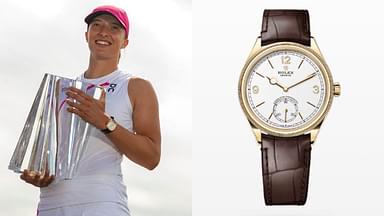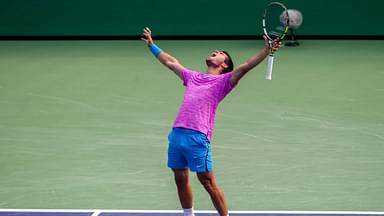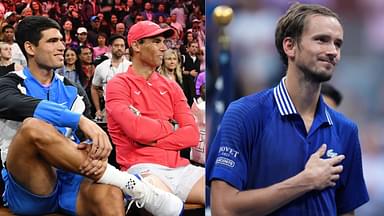Carlos Alcaraz reached the top of the tennis world after this Wimbledon triumph and won his first title after that on Sunday at Indian Wells 2024. The Spaniard’s trademark smile has made more of a comeback after enduring a difficult phase in between all of that.
Carlos Alcaraz looked flawless at the Indian Wells. The 20-year-old defeated Jannik Sinner in the semi-final and then proceeded to beat Daniil Medvedev in the final on Sunday. While Alcaraz is hell bent on making his own legacy, he is set to invite more comparisons with his ‘idol’ from Spain, Rafael Nadal.
It seems Carlos Alcaraz wants to be remembered as someone who is more open, a people’s favorite and a happy-go-lucky person who wants to enjoy himself on court playing tennis as much as off court in life, and show it too. Perhaps, it has also got to do with the social media age where Alcaraz, being from the younger generation, is looking to come across as more relatable with his successes and failures alike like a normal human being despite all the stardom he has gained before even turning 21.
Alcaraz puts a lot of importance on carrying a smile and being positive. The 20-year-old was open about his struggles and never shied away from criticism. Despite his form, Alcaraz has generally remained a fan favorite and smiled through the tough times. Tennis journalist Jonathan Pinfield asked Alcaraz during the Roland Garros 2023 about his reason behind him smiling all the time.
“I always say that smiling is for me is the key for everything. I enjoy these main tournaments and series and that’s why I smile all the time.”
During the Indian Wells 2024 competition, Carlos Alcaraz candidly opened up about how he struggled to handle the excessive trolling he was subjected to on social media during the time when form and fitness was not on his side. Like most youngsters around the world, Alcaraz is an avid smartphone and social media user too. He was quoted as saying in one of the press conferences –
“Well, I think for me, it’s a little bit difficult to be myself, let’s say, the last few months or the past few tournaments.
“I was trying to enjoy, let’s say, every match, every point, but it was difficult for me, you know, to stay there in high intensity, high level of pressure, let’s say. It was difficult for me to deal with it, but I try to stay away for everything and try to enjoy the court. I think that’s the most important thing for me.
“You know, as I said many times, I’m a guy that sees a lot of the phone, and I see a lot of comments that the people give to you. Most of them are really good ones, but a few of them is the bad ones. You know, it’s difficult to deal with it, but, yes, that’s what I’m trying to do, to stay away from everything, be myself and enjoy every time that I step on the court.”
One of those instances of trolling was when Carlos Alcaraz at least admitted that he always looks up to Novak Djokovic and is often the man to beat in his eyes. Many took it as an obsession he has with the Serb after their rivalry in 2023, despite coach Juan Carlos Ferrero denying it.
How is Rafael Nadal different from Carlos Alcaraz in this regard
While Carlos Alcaraz has his flashy, trademark smile to show naturally as a person, Rafael Nadal has his smile coming out rarely on the court at least. The 22-time Grand Slam champion is an epitome of having unmatched intensity and aggression on court and yet someone who is interestingly and mainly Zen-like when it comes to externally reacting to winning and losing any point, game, set, match or even a tournament in general.
Toni Nadal, Rafa’s first coach, made it abundantly clear to him when training him while growing up that his attitude will not change in court irrespective of what happens. This explains why Nadal has not broken a single racket in his career and has hardly got into a beef with his opponents, umpires or line judges on court.
Rafael Nadal is one person who takes his job seriously and this has a lot to do with the fact that he wishes to be remembered as a competitive beast who never gave up and played every point like it was his last.
Interestingly, while Carlos Alcaraz will want to be liked more, Rafael Nadal wants to be more respected and a role model to be looked up to for his fans. And yet even then, both the Spanish superstars are extremely humble off the court with their gestures towards fans in the stadium, ball boys/ball girls, opponents and people from different walks of life.
Rafael Nadal is considered to be an extremely private and reserved person off court, who carefully chooses his words and is old-school style, professional enough to deal with the media otherwise. This seems to have worked well for the Spaniard over the years, who is now the most followed tennis player on the planet on Instagram, entertaining fans with some top-quality content. In that sense, Nadal is changing with times to remain relevant to younger audiences by giving slight access to his life, without compromising on his privacy.
Carlos Alcaraz is more organic, with not much to hide and that is the beauty of sport. Players from the same country, similar upbringing and likings can have similar yet such different personalities and with different goals, and can be likeable.







